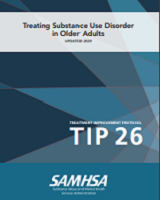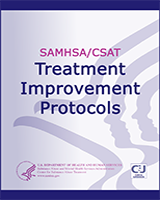NCBI Bookshelf. A service of the National Library of Medicine, National Institutes of Health.
This publication is provided for historical reference only and the information may be out of date.
This TIP, Substance Abuse Among Older Adults, presents treatment providers with much-needed information about a population that is underdiagnosed and underserved. Substance abuse, particularly of alcohol and prescription drugs, often goes undetected among adults over 60 in part due to societal reasons - older adults tend to be ashamed about drinking or drug problems and see them as a moral failing. Providers, for their part, may confuse symptoms of substance use disorders with age-related changes. Because so much of older adults' substance abuse is never even identified, this TIP is aimed at not only substance abuse treatment providers but also primary care clinicians, social workers, senior center staff, and anyone else who has regular contact with older adults.
The TIP discusses the relationship between aging and substance abuse and offers guidance on identifying, screening, and assessing not only substance abuse but also disorders such as dementia and delirium that can mask or mimic an alcohol or prescription drug problem. Practical accommodations to treatment for older adults and a discussion of how to assess outcomes and treat within a managed care context round out the document.
Contents
- What Is a TIP?
- Editorial Advisory Board
- Consensus Panel
- Foreword
- Executive Summary and Recommendations
- Chapter 1 - Substance Abuse Among Older Adults: An Invisible Epidemic
- Chapter 2 - Alcohol
- Chapter 3 - Use and Abuse of Psychoactive Prescription Drugs and Over-the-Counter Medications
- Chapter 4 - Identification, Screening, and Assessment
- Chapter 5 - Referral and Treatment Approaches
- Chapter 6 - Outcomes and Cost Issues in Alcohol Treatment for Older Adults
- Appendix A - Legal and Ethical Issues
- Appendix B - Tools
- Appendix C - Bibliography
- Appendix D - Resource Panel
- Appendix E - Field Reviewers
The opinions expressed herein are the views of the Consensus Panel members and do not reflect the official position of CSAT, SAMHSA, or the U.S. Department of Health and Human Services (DHHS). No official support or endorsement of CSAT, SAMHSA, or DHHS for these opinions or for particular instruments or software that may be described in this document is intended or should be inferred. The guidelines in this document should not be considered substitutes for individualized patient care and treatment decisions.
- Review Psychoactive drug abuse in older adults.[Am J Geriatr Pharmacother. 2006]Review Psychoactive drug abuse in older adults.Simoni-Wastila L, Yang HK. Am J Geriatr Pharmacother. 2006 Dec; 4(4):380-94.
- The impact of knowledge on attitudes of emergency department staff towards patients with substance related presentations: a quantitative systematic review protocol.[JBI Database System Rev Implem...]The impact of knowledge on attitudes of emergency department staff towards patients with substance related presentations: a quantitative systematic review protocol.Clarke DE, Gonzalez M, Pereira A, Boyce-Gaudreau K, Waldman C, Demczuk L. JBI Database System Rev Implement Rep. 2015 Oct; 13(10):133-45.
- Are clinical impressions of adolescent substance use accurate?[Pediatrics. 2004]Are clinical impressions of adolescent substance use accurate?Wilson CR, Sherritt L, Gates E, Knight JR. Pediatrics. 2004 Nov; 114(5):e536-40.
- Just say know: an examination of substance use disorders among older adults in gerontological and substance abuse journals.[Soc Work Public Health. 2013]Just say know: an examination of substance use disorders among older adults in gerontological and substance abuse journals.Rosen D, Engel RJ, Hunsaker AE, Engel Y, Detlefsen EG, Reynolds CF 3rd. Soc Work Public Health. 2013; 28(3-4):377-87.
- Review Substance Use Disorder in Older Adults: Mini Review.[Addict Health. 2022]Review Substance Use Disorder in Older Adults: Mini Review.Jaqua EE, Nguyen V, Scherlie N, Dreschler J, Labib W. Addict Health. 2022 Jan; 14(1):62-67.
- Substance Abuse Among Older AdultsSubstance Abuse Among Older Adults
- NADH dehydrogenase, partial (chloroplast) [Acilepis ngaoensis]NADH dehydrogenase, partial (chloroplast) [Acilepis ngaoensis]gi|658306564|gb|AID59266.1|Protein
- ATP synthase beta subunit, partial (chloroplast) [Phryma sp. Chase & Fay 14591]ATP synthase beta subunit, partial (chloroplast) [Phryma sp. Chase & Fay 14591]gi|310109902|gb|ADP00887.1|Protein
- Uncultured bacterium #0319-6D13 16S ribosomal RNA gene, partial sequenceUncultured bacterium #0319-6D13 16S ribosomal RNA gene, partial sequencegi|7208494|gb|AF234069.1|Nucleotide
Your browsing activity is empty.
Activity recording is turned off.
See more...

